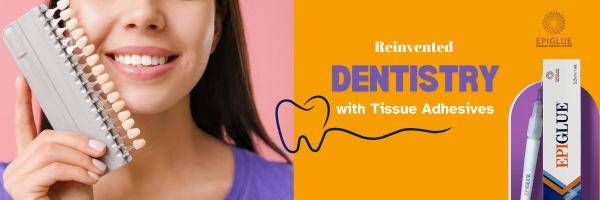
In the always-changing area of dentistry, new ideas are always coming up to improve care for patients, make treatments more effective, and make procedures easier. One such improvement that has become more popular recently is the use of glues to stick tissues together. These adhesives, which are also called dental glues or dental adhesives, are very important for many dental procedures and are good for both patients and dental workers in many ways.
Sutures or mechanical fasteners were often used in the past in dental treatments to hold tissues in place after surgery or trauma. Even though these methods worked, they had some problems. For example, they made the patient uncomfortable, raised the risk of infection, and could damage tissue during removal. Tissue bonds have changed this part of dentistry by making an easy, effective, and less invasive option available.
In dentistry, one of the main uses of tissue glue is to close up wounds. These adhesives are great for finishing up surgical cuts, scrapes, or gingival flaps because they stick very well and help the wound heal faster. They make a waterproof barrier that keeps outside germs from getting into the wound, which lowers the risk of infection and problems after surgery. Tissue adhesives also get rid of the need for stitches, which makes patients feel better and speeds up their healing.
Tissue adhesives are also used a lot in reconstructive dentistry, especially to attach dental materials like veneers, composite resins, and ceramics to tooth structure. Because they are strong adhesives and can make seamless bonds, these adhesives make sure that restorations last and can handle the wear and tear of everyday mouth function. This not only makes dental replacements last longer, but it also makes them look better, giving patients smiles that look more natural.
Tissue adhesives are very useful in braces for attaching brackets, bands, and other devices to teeth. They are also used to close wounds and fix broken bones. The accuracy and dependability of these adhesives make it easier to place orthodontic attachments correctly, which ensures the best possible treatment results. In addition, their ability to withstand the stresses that come from speaking and chewing helps keep orthodontic treatments stable and effective.
One of the best things about paper adhesives is how versatile and easy they are to use. They come in different types, such as cyanoacrylate-based adhesives that quickly harden when they come in contact with water and light-cured adhesives that let you precisely control the setting time. Because of this, dental workers can pick the best adhesive for each case, which makes the dental office run more smoothly and efficiently.
Even though tissue bonds have many benefits, it is important to be careful and use them correctly when using them in dentistry. Carefully preparing the surfaces that will be bonded, controlling the moisture well, and placing the glue exactly where it needs to be are all important parts of the bonding process. To get the best results and avoid problems, patients must also be properly educated about how to care for themselves after surgery and keep up with upkeep.
In conclusion, tissue bonds are a big step forward in modern dentistry because they make wound closure, restorative procedures, and orthodontic treatments safer, more effective, and less invasive. They are essential tools for dental workers because they make strong, long-lasting bonds, make patients more comfortable, and speed up clinical workflows. As technology keeps getting better, the future holds even more hope for the creation of new adhesive materials that will make dentists even better.

Leave a Reply